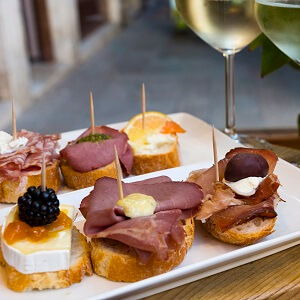Brimming with culture, water and people, Venice is a unique destination which deserves to be properly explored. That’s why we’ve come up with a list of the best things to see.
One of the most picture-perfect cities in Italy, Venice is tightly packed with Renaissance and Gothic architecture, spanning across ancient palaces, world-class museums, and iconic art collections, to more contemporary exhibits. Comprising of six sestere (or districts), the floating city of Venice offers something worth exploring at every turn. You’re spoilt for choice! Not to worry however, we’ve crafted a list of top things to see in Venice.
-
St. Mark’s Square:
St. Mark’s Square is the largest public square of Venice, nestled in the beating heart of the city. It houses important government buildings and various facilities central to the city including the magnificent St. Mark’s Cathedral that showcases a mixture of Venetian-Byzantine style architecture. The best things to do here? Capture a panoramic view of the city, or run through feeding the pigeons, and take a casual stroll in downtown Venice.
-
The Bridge of Sighs:
Perhaps the city’s most picturesque architectural marvel, the Bridge of Sighs is tucked inside the city centre near St. Mark’s square. The bridge is part of the Doge’s Palace prison complex, and was one of the last things that the convicts saw before their incarceration. So, it derives its name from the fact that many sighs could be heard as the prisoners took their last walk through the bridge, surrendering themselves to their imminent fate. Fortunately, today the ‘bridge of sighs’ has much happier connotations, with truckloads of tourists flocking to witness its stunning design.
-
Doge’s Palace:
A lavish, royal palace that boasts Venetian Gothic style architecture, the Doge’s Palace was once the home of the Doge (ruler of Venice). From its striking exterior, adorned with a Gothic style open portico and a second-floor balcony, to its marvellous interior complemented by gilded ceilings, and frescoed walls, the Palazzo Ducale is a must-have experience in Venice. Don’t forget to take your camera along for this one!
-
Peggy Guggenheim Collection:
The Peggy Guggenheim Collection is one of Europe’s premier art museums that boasts of the artworks of the most influential Romanian artists of the 20th century. In addition to displaying an incredible panoply of futurist, surrealist art, the museum also has a stockpile of works from the avant-garde European and American artists, including Pablo Picasso, Jackson Pollock, and Alexander Calder. Not just for art enthusiasts, anyone can appreciate the colourful masterpieces that have become renown around the world.
-
Venetian Ghetto:
Come home to the Jewish District of Venice to marvel at the world’s first ever Ghetto, which was established in 1516 as an area where Jews were compelled to live by the Government of the Venetian Republic. Today, the area has become a fascinating source of Jewish culture and history with several synagogues, museums and Jewish restaurants, making a memorable experience for all.
-
Rialto Bridge:
The oldest of the four bridges spanning the Grand Canal, the Rialto Bridge has been rebuilt several times since its first construction as a pontoon bridge in the 12th century. Pontoon bridges are floating bridges which use buoyancy to support the crossing of pedestrian’s or vehicles. Due to it being one of the first dry crossings of the Grand Canal, the bridge became very popular, and increasing traffic saw it develop into a wooden bridge in 1255. It then collapsed in 1444 under the weight of a crowd watching a boat parade, which initiated its stone construction. A bridge which has seen so much history and is clearly loved by the people of Venice is worth a wander to.
-
Burano:
A trip to Burano will make you feel like you’ve just dropped straight into a children’s programme. With brightly painted houses, turquoise water and boats lining the cobbled side paths, the island of Burano is an impossibly charming town full of colour and simple Venetian lifestyle. Made famous for its fishing and lacemaking, the colourful patchwork of houses are favoured by fisherman as a way to navigate themselves back to their homes across the lagoon, especially in foggy weather. With around 2,000 full time residents, the village is still rather quiet, but a day trip to try the local seafood and purchase a bit of homemade lace is definitely worth the boat ride.
-
Grand Canal:
The main traffic corridor of Venice, the grand canal is as old as the city itself and an inherent part of it at that. The canal is the main channel in Venice, leading into the lagoon near the Santa Lucia railway station on one side, and the basin at San Marco on the other. It snakes its way through the city forming a reverse S-shape through the central districts (sestieri). One of the only ways to see the front of some of the buildings in Venice is to take a boat along the grand canal so you can get a peek at them from the water.
-
Teatro la Fenice:
This breathtakingly beautiful opera house is one of the most famous and renowned landmarks in the history of Italian theatre. Its history is one of tragedy and scandal. After the theatre was damaged by two fires, one in 1774 and another in 1836, parts of the leading house were quickly rebuilt. The third fire however, caused as a result of arson in 1996, left irrep able damage, leaving only the exterior walls. This led to a complete rebuild of the theatre which wasn’t re-opened until November 2004. Today however, there is no trace of the opera houses’ tragic past, as its interior glows brightly in red and gold with a grand chandelier hanging from the centre of the ornately decorated ceiling. Go and overwhelm your sense as you take in this magnificent building whilst listening to the opera.
If this isn’t enough to quench your appetite for Venice, then check out our tours below find an itinerary that suits you.
Discover the Best Venice Tours
-
Private Venice Gondola Tour
30 Mins
€125
See More -
Afternoon Venice Islands To Murano, Burano & Torcello Tour
4.5 Hours
€19
See More -
Venice Food Tour with Lunch
2.5 Hours
€79
See More -
Discover Venice Day Tour
3.5 Hours
€120
See More





